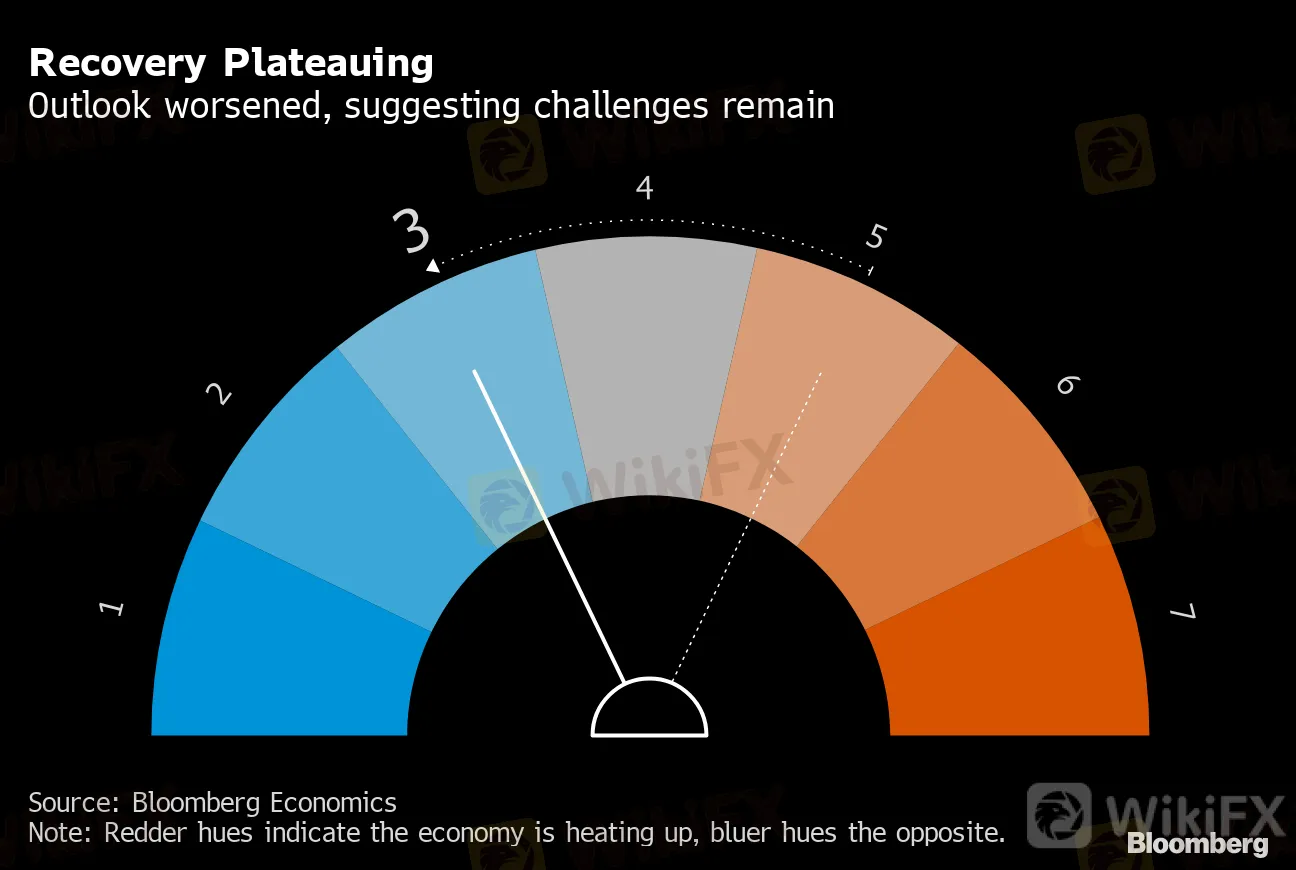简体中文
繁體中文
English
Pусский
日本語
ภาษาไทย
Tiếng Việt
Bahasa Indonesia
Español
हिन्दी
Filippiiniläinen
Français
Deutsch
Português
Türkçe
한국어
العربية
Chinas Rebound Lost Momentum in September, Early Data Show
Abstract:Chinas economic rebound showed signs of plateauing in September, weighed down by lackluster home and car sales, a weaker stock market and worsening business confidence.
Chinas economic rebound showed signs of plateauing in September, weighed down by lackluster home and car sales, a weaker stock market and worsening business confidence.
Recovery Plateauing
Outlook worsened, suggesting challenges remain
Source: Bloomberg Economics
Note: Redder hues indicate the economy is heating up, bluer hues the opposite.

That‘s the assessment from the earliest available indicators, which showed China’s recovery is losing pace. The aggregate index combining eight indicators tracked by Bloomberg this month slipped into contraction, compared to accelerated expansion in August.
China has staged an uneven recovery, initially driven by strong industrial output yet with recent data showing signs that consumption has started to catch up. A strong and broad spurt in spending is needed for a more meaningful economic rebound.
New home sales in China‘s four biggest cities slowed in the first three weeks of September, reversing August’s pickup. Small-business confidence eased marginally after rising for six straight months, while a gauge of expectations rose further into growth territory.
Weak Demand
Both home sales and car sales fell
Source: Bloomberg Economics, data compiled by Bloomberg

The pace of economic expansion moderated marginally for small businesses in September, despite continued recovery, according to Standard Chartered Plc, which surveys more than 500 smaller firms each month. The growth momentum indicator eased from a month ago and the “current performance” reading retreated for the first time since March.
{777}
“This suggests that the recovery continued uninterrupted, despite signs that the V-shaped rebound is losing momentum,” according to economists Shen Lan and Ding Shuang, who published the results. “SMEs‘ new orders slowed in September” and the pace of expansion of banks’ credit to SMEs also eased, they said.
{777}
Purchasing manager indexes due Wednesday are expected to show September manufacturing improved slightly while non-manufacturing moderated from Augusts level.
Dim Outlook
Business confidence slipping and stocks trending lower
Source: Data compiled by Bloomberg

Exports for smaller businesses remained resilient, according to Standard Chartered, with export-oriented SMEs performing better than domestically focused ones in the month.
{33}
The outlook for global trade remains more encouraging, with Korean exports in the first 20 days of September up 3.6% from a year earlier, the first rise in early trade data since March. Average daily shipments from South Korea, however, offered a less optimistic picture, falling by 9.8% as the period had two more working days compared with last year.
{33}
South Koreas exports serve as a barometer of global trade as its companies are closely linked to global manufacturing-supply chains, and it releases data quickly.
Early Indicators
From July, Bloomberg has changed some of the components for the early look at Chinas economy. It added home sales in the biggest four cities, weekly car sales and inventories of steel reinforcing, while removing iron-ore prices, sales manager sentiment and property-related stocks.
Bloomberg Economics generates the overall activity reading by aggregating a three-month weighted average of the monthly changes of eight indicators, which are based on business surveys or market prices.
Major onshore stocks - CSI 300 index of A-share stocks listed in Shanghai or Shenzhen (through market close on 25th of the month).
Total floor area of home sales in Chinas four Tier-1 cities (Beijing, Shanghai, Guangzhou and Shenzhen).
Inventory of steel rebar, used for reinforcing in construction (in 10,000 metric tones). Falling inventory is a sign of rising demand.
Copper prices - Spot price for refined copper in Shanghai market (yuan/metric tonne).
South Korean exports - South Korean exports in the first 20 days of each month (year-on-year change).
{43}
Factory inflation tracker - Bloomberg Economics created tracker for Chinese producer prices (year-on-year change).
{43}
Small and medium-sized business confidence - Survey of companies conducted by Standard Chartered.
Passenger car sales - Monthly result calculated from the weekly average sales data released by the China Passenger Car Association.
— With assistance by James Mayger, and Lin Zhu
Disclaimer:
The views in this article only represent the author's personal views, and do not constitute investment advice on this platform. This platform does not guarantee the accuracy, completeness and timeliness of the information in the article, and will not be liable for any loss caused by the use of or reliance on the information in the article.
WikiFX Broker
Latest News
Brazilian Man Charged in $290 Million Crypto Ponzi Scheme Affecting 126,000 Investors
Become a Full-Time FX Trader in 6 Simple Steps
ATFX Enhances Trading Platform with BlackArrow Integration
IG 2025 Most Comprehensive Review
SEC Drops Coinbase Lawsuit, Signals Crypto Policy Shift
Construction Datuk Director Loses RM26.6 Mil to UVKXE Crypto Scam
Should You Choose Rock-West or Avoid it?
Franklin Templeton Submitted S-1 Filing for Spot Solana ETF to the SEC on February 21
Scam Couple behind NECCORPO Arrested by Thai Authorities
Top Profitable Forex Trading Strategies for New Traders
Currency Calculator






